Developing Individual, Teams, and Organisation: Whirlpool Report
VerifiedAdded on 2021/01/02
|15
|4626
|459
Report
AI Summary
This report delves into the essential skills and knowledge required of HR professionals, using Whirlpool, a global home appliance manufacturer, as a case study. It examines communication, decision-making, and ethical behavior as crucial skills for HR managers. The report includes a personal skills audit and a personal development plan (PDP) to identify and address skill gaps. Furthermore, it analyzes the differences between organizational and individual learning, training, and development approaches. The report also explores the role of high-performance work (HPW) in employee engagement and competitive advantage, alongside different performance management strategies. The report concludes by emphasizing the importance of continuous learning and professional development for sustainable business performance within the dynamic competitive environment.
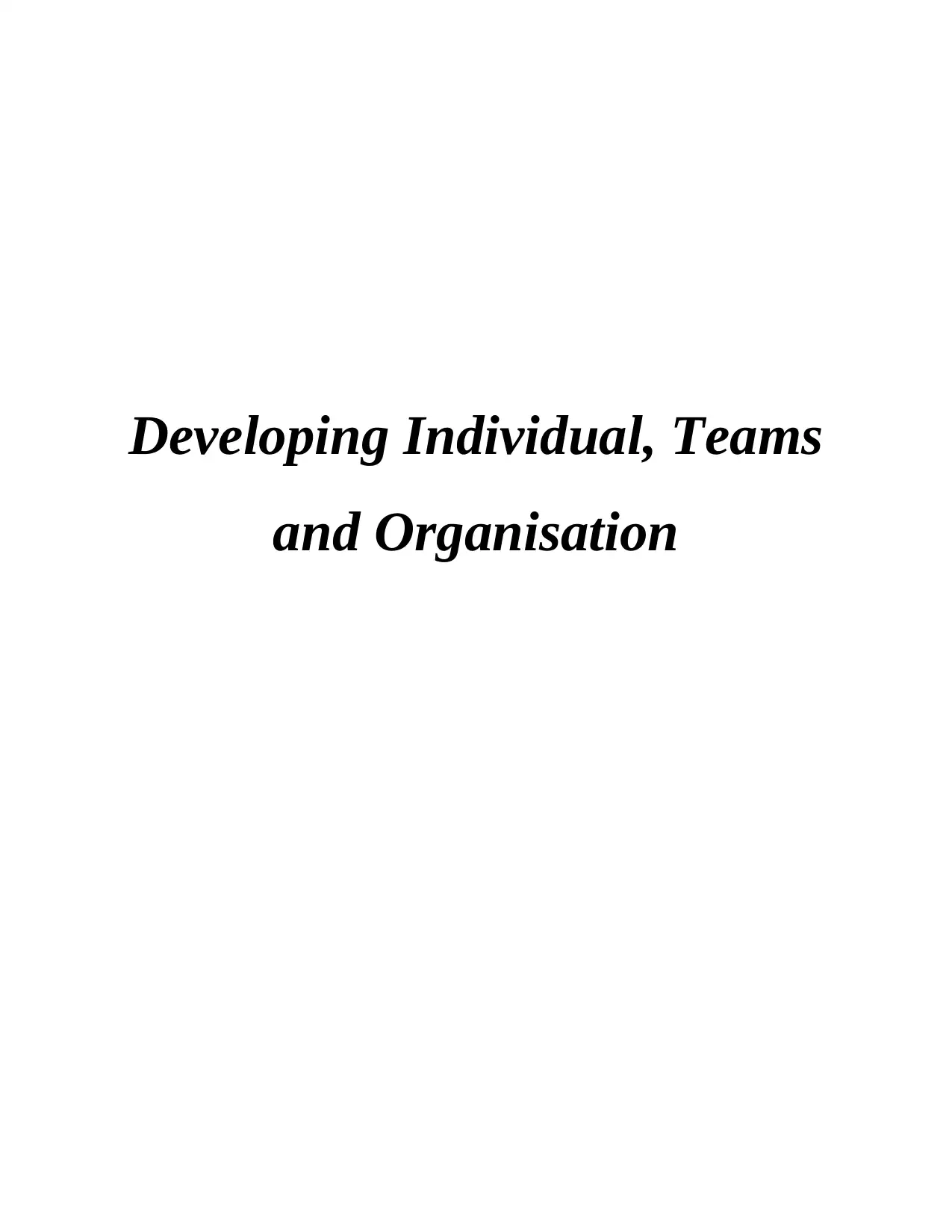
Developing Individual, Teams
and Organisation
and Organisation
Paraphrase This Document
Need a fresh take? Get an instant paraphrase of this document with our AI Paraphraser
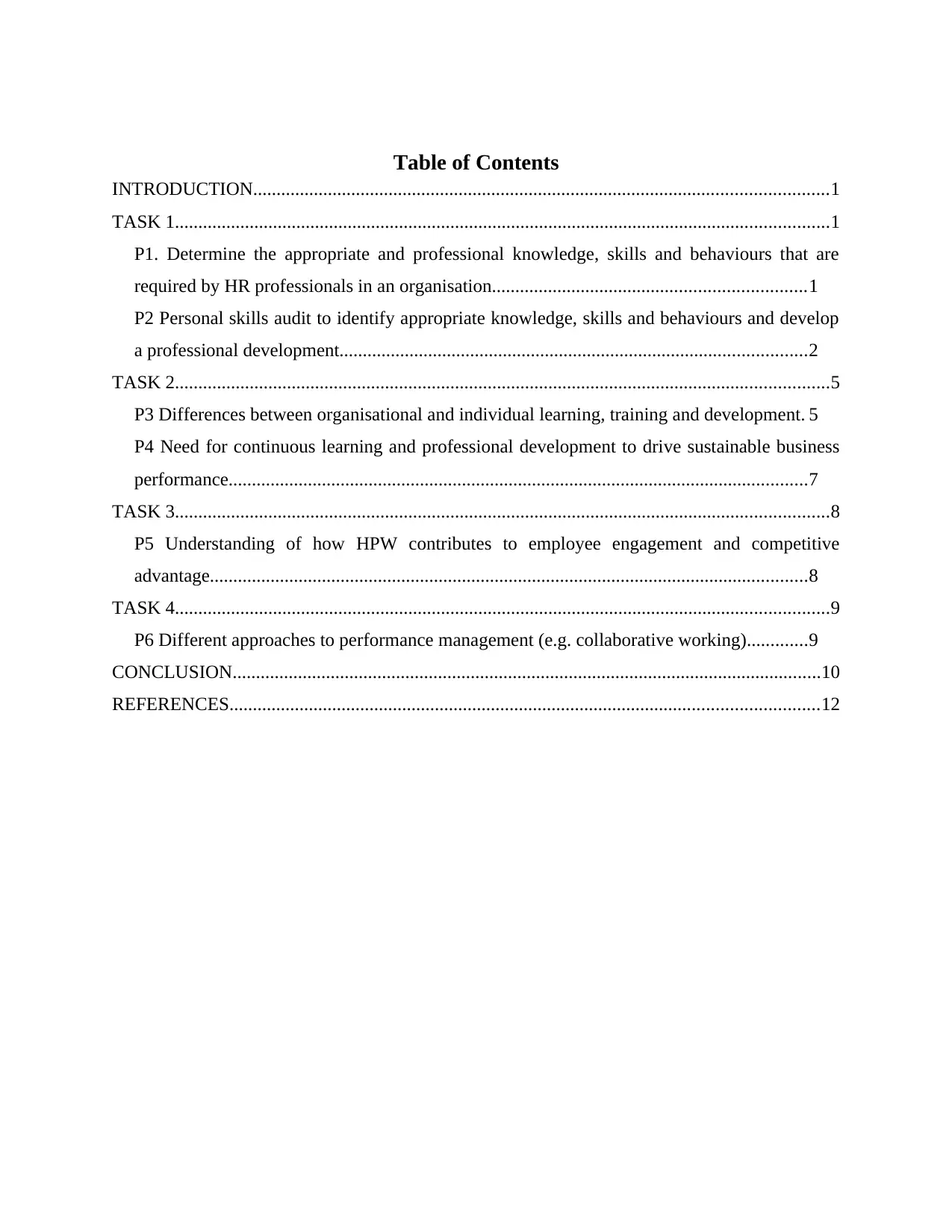
Table of Contents
INTRODUCTION...........................................................................................................................1
TASK 1............................................................................................................................................1
P1. Determine the appropriate and professional knowledge, skills and behaviours that are
required by HR professionals in an organisation...................................................................1
P2 Personal skills audit to identify appropriate knowledge, skills and behaviours and develop
a professional development....................................................................................................2
TASK 2............................................................................................................................................5
P3 Differences between organisational and individual learning, training and development. 5
P4 Need for continuous learning and professional development to drive sustainable business
performance............................................................................................................................7
TASK 3............................................................................................................................................8
P5 Understanding of how HPW contributes to employee engagement and competitive
advantage................................................................................................................................8
TASK 4............................................................................................................................................9
P6 Different approaches to performance management (e.g. collaborative working).............9
CONCLUSION..............................................................................................................................10
REFERENCES..............................................................................................................................12
INTRODUCTION...........................................................................................................................1
TASK 1............................................................................................................................................1
P1. Determine the appropriate and professional knowledge, skills and behaviours that are
required by HR professionals in an organisation...................................................................1
P2 Personal skills audit to identify appropriate knowledge, skills and behaviours and develop
a professional development....................................................................................................2
TASK 2............................................................................................................................................5
P3 Differences between organisational and individual learning, training and development. 5
P4 Need for continuous learning and professional development to drive sustainable business
performance............................................................................................................................7
TASK 3............................................................................................................................................8
P5 Understanding of how HPW contributes to employee engagement and competitive
advantage................................................................................................................................8
TASK 4............................................................................................................................................9
P6 Different approaches to performance management (e.g. collaborative working).............9
CONCLUSION..............................................................................................................................10
REFERENCES..............................................................................................................................12
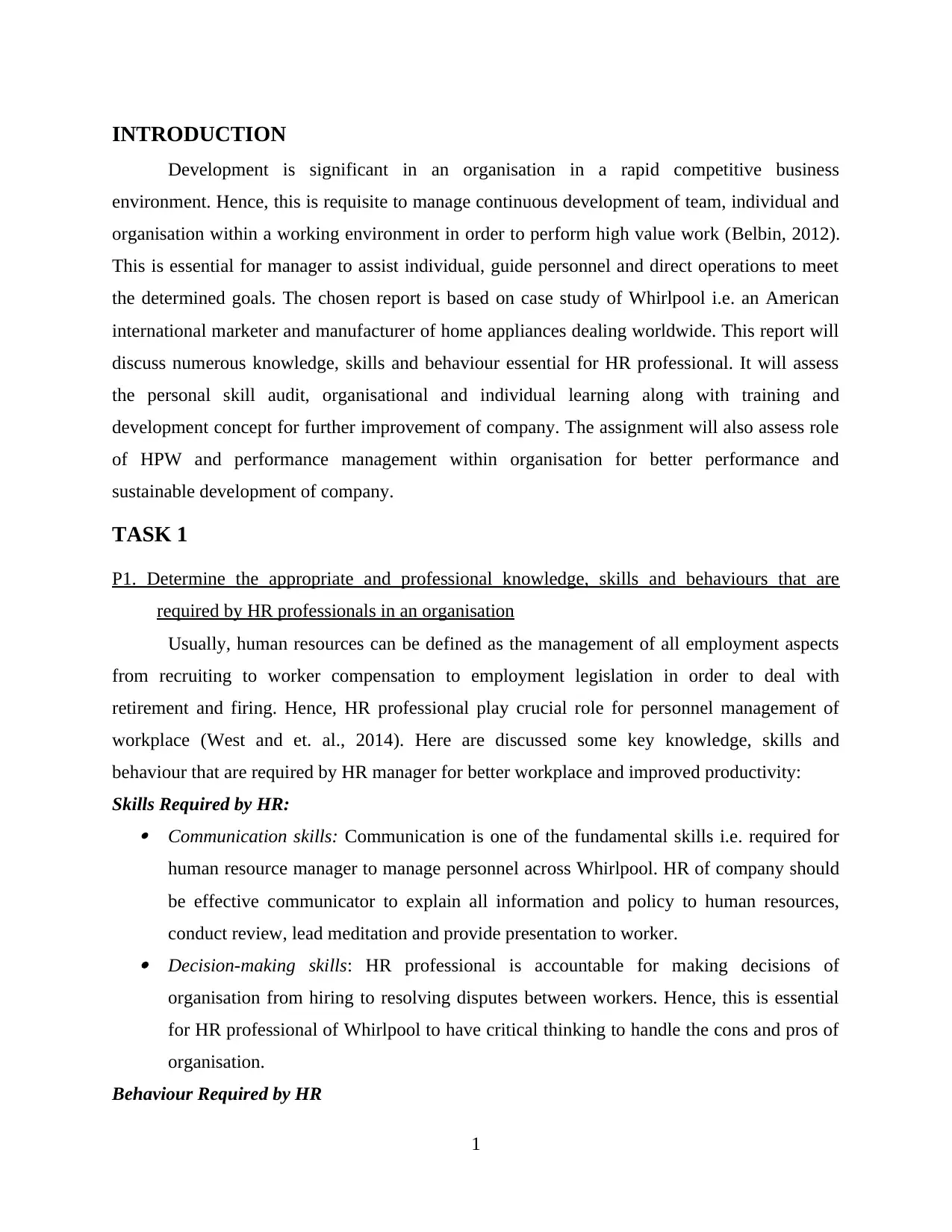
INTRODUCTION
Development is significant in an organisation in a rapid competitive business
environment. Hence, this is requisite to manage continuous development of team, individual and
organisation within a working environment in order to perform high value work (Belbin, 2012).
This is essential for manager to assist individual, guide personnel and direct operations to meet
the determined goals. The chosen report is based on case study of Whirlpool i.e. an American
international marketer and manufacturer of home appliances dealing worldwide. This report will
discuss numerous knowledge, skills and behaviour essential for HR professional. It will assess
the personal skill audit, organisational and individual learning along with training and
development concept for further improvement of company. The assignment will also assess role
of HPW and performance management within organisation for better performance and
sustainable development of company.
TASK 1
P1. Determine the appropriate and professional knowledge, skills and behaviours that are
required by HR professionals in an organisation
Usually, human resources can be defined as the management of all employment aspects
from recruiting to worker compensation to employment legislation in order to deal with
retirement and firing. Hence, HR professional play crucial role for personnel management of
workplace (West and et. al., 2014). Here are discussed some key knowledge, skills and
behaviour that are required by HR manager for better workplace and improved productivity:
Skills Required by HR: Communication skills: Communication is one of the fundamental skills i.e. required for
human resource manager to manage personnel across Whirlpool. HR of company should
be effective communicator to explain all information and policy to human resources,
conduct review, lead meditation and provide presentation to worker. Decision-making skills: HR professional is accountable for making decisions of
organisation from hiring to resolving disputes between workers. Hence, this is essential
for HR professional of Whirlpool to have critical thinking to handle the cons and pros of
organisation.
Behaviour Required by HR
1
Development is significant in an organisation in a rapid competitive business
environment. Hence, this is requisite to manage continuous development of team, individual and
organisation within a working environment in order to perform high value work (Belbin, 2012).
This is essential for manager to assist individual, guide personnel and direct operations to meet
the determined goals. The chosen report is based on case study of Whirlpool i.e. an American
international marketer and manufacturer of home appliances dealing worldwide. This report will
discuss numerous knowledge, skills and behaviour essential for HR professional. It will assess
the personal skill audit, organisational and individual learning along with training and
development concept for further improvement of company. The assignment will also assess role
of HPW and performance management within organisation for better performance and
sustainable development of company.
TASK 1
P1. Determine the appropriate and professional knowledge, skills and behaviours that are
required by HR professionals in an organisation
Usually, human resources can be defined as the management of all employment aspects
from recruiting to worker compensation to employment legislation in order to deal with
retirement and firing. Hence, HR professional play crucial role for personnel management of
workplace (West and et. al., 2014). Here are discussed some key knowledge, skills and
behaviour that are required by HR manager for better workplace and improved productivity:
Skills Required by HR: Communication skills: Communication is one of the fundamental skills i.e. required for
human resource manager to manage personnel across Whirlpool. HR of company should
be effective communicator to explain all information and policy to human resources,
conduct review, lead meditation and provide presentation to worker. Decision-making skills: HR professional is accountable for making decisions of
organisation from hiring to resolving disputes between workers. Hence, this is essential
for HR professional of Whirlpool to have critical thinking to handle the cons and pros of
organisation.
Behaviour Required by HR
1
⊘ This is a preview!⊘
Do you want full access?
Subscribe today to unlock all pages.

Trusted by 1+ million students worldwide
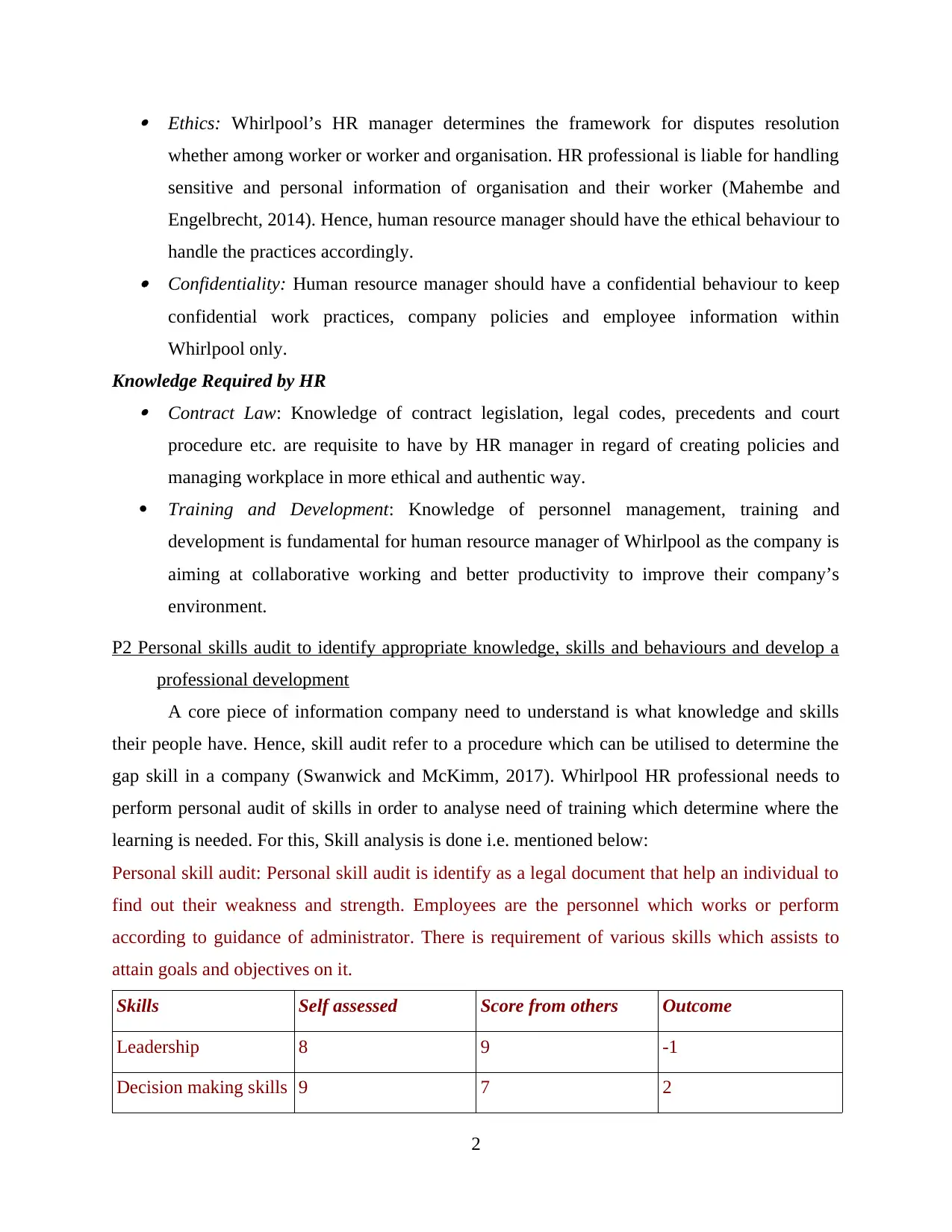
Ethics: Whirlpool’s HR manager determines the framework for disputes resolution
whether among worker or worker and organisation. HR professional is liable for handling
sensitive and personal information of organisation and their worker (Mahembe and
Engelbrecht, 2014). Hence, human resource manager should have the ethical behaviour to
handle the practices accordingly. Confidentiality: Human resource manager should have a confidential behaviour to keep
confidential work practices, company policies and employee information within
Whirlpool only.
Knowledge Required by HR Contract Law: Knowledge of contract legislation, legal codes, precedents and court
procedure etc. are requisite to have by HR manager in regard of creating policies and
managing workplace in more ethical and authentic way.
Training and Development: Knowledge of personnel management, training and
development is fundamental for human resource manager of Whirlpool as the company is
aiming at collaborative working and better productivity to improve their company’s
environment.
P2 Personal skills audit to identify appropriate knowledge, skills and behaviours and develop a
professional development
A core piece of information company need to understand is what knowledge and skills
their people have. Hence, skill audit refer to a procedure which can be utilised to determine the
gap skill in a company (Swanwick and McKimm, 2017). Whirlpool HR professional needs to
perform personal audit of skills in order to analyse need of training which determine where the
learning is needed. For this, Skill analysis is done i.e. mentioned below:
Personal skill audit: Personal skill audit is identify as a legal document that help an individual to
find out their weakness and strength. Employees are the personnel which works or perform
according to guidance of administrator. There is requirement of various skills which assists to
attain goals and objectives on it.
Skills Self assessed Score from others Outcome
Leadership 8 9 -1
Decision making skills 9 7 2
2
whether among worker or worker and organisation. HR professional is liable for handling
sensitive and personal information of organisation and their worker (Mahembe and
Engelbrecht, 2014). Hence, human resource manager should have the ethical behaviour to
handle the practices accordingly. Confidentiality: Human resource manager should have a confidential behaviour to keep
confidential work practices, company policies and employee information within
Whirlpool only.
Knowledge Required by HR Contract Law: Knowledge of contract legislation, legal codes, precedents and court
procedure etc. are requisite to have by HR manager in regard of creating policies and
managing workplace in more ethical and authentic way.
Training and Development: Knowledge of personnel management, training and
development is fundamental for human resource manager of Whirlpool as the company is
aiming at collaborative working and better productivity to improve their company’s
environment.
P2 Personal skills audit to identify appropriate knowledge, skills and behaviours and develop a
professional development
A core piece of information company need to understand is what knowledge and skills
their people have. Hence, skill audit refer to a procedure which can be utilised to determine the
gap skill in a company (Swanwick and McKimm, 2017). Whirlpool HR professional needs to
perform personal audit of skills in order to analyse need of training which determine where the
learning is needed. For this, Skill analysis is done i.e. mentioned below:
Personal skill audit: Personal skill audit is identify as a legal document that help an individual to
find out their weakness and strength. Employees are the personnel which works or perform
according to guidance of administrator. There is requirement of various skills which assists to
attain goals and objectives on it.
Skills Self assessed Score from others Outcome
Leadership 8 9 -1
Decision making skills 9 7 2
2
Paraphrase This Document
Need a fresh take? Get an instant paraphrase of this document with our AI Paraphraser
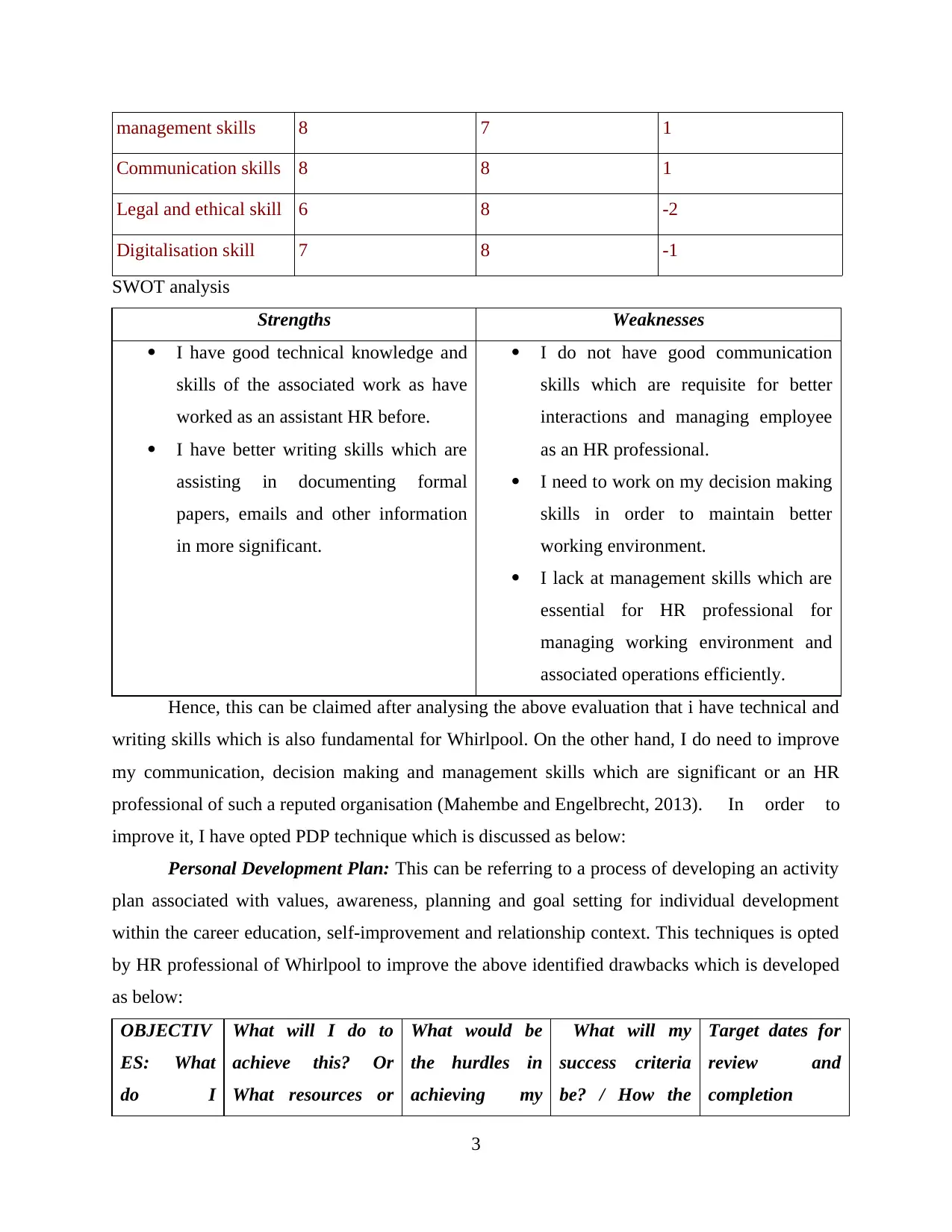
management skills 8 7 1
Communication skills 8 8 1
Legal and ethical skill 6 8 -2
Digitalisation skill 7 8 -1
SWOT analysis
Strengths Weaknesses
I have good technical knowledge and
skills of the associated work as have
worked as an assistant HR before.
I have better writing skills which are
assisting in documenting formal
papers, emails and other information
in more significant.
I do not have good communication
skills which are requisite for better
interactions and managing employee
as an HR professional.
I need to work on my decision making
skills in order to maintain better
working environment.
I lack at management skills which are
essential for HR professional for
managing working environment and
associated operations efficiently.
Hence, this can be claimed after analysing the above evaluation that i have technical and
writing skills which is also fundamental for Whirlpool. On the other hand, I do need to improve
my communication, decision making and management skills which are significant or an HR
professional of such a reputed organisation (Mahembe and Engelbrecht, 2013). In order to
improve it, I have opted PDP technique which is discussed as below:
Personal Development Plan: This can be referring to a process of developing an activity
plan associated with values, awareness, planning and goal setting for individual development
within the career education, self-improvement and relationship context. This techniques is opted
by HR professional of Whirlpool to improve the above identified drawbacks which is developed
as below:
OBJECTIV
ES: What
do I
What will I do to
achieve this? Or
What resources or
What would be
the hurdles in
achieving my
What will my
success criteria
be? / How the
Target dates for
review and
completion
3
Communication skills 8 8 1
Legal and ethical skill 6 8 -2
Digitalisation skill 7 8 -1
SWOT analysis
Strengths Weaknesses
I have good technical knowledge and
skills of the associated work as have
worked as an assistant HR before.
I have better writing skills which are
assisting in documenting formal
papers, emails and other information
in more significant.
I do not have good communication
skills which are requisite for better
interactions and managing employee
as an HR professional.
I need to work on my decision making
skills in order to maintain better
working environment.
I lack at management skills which are
essential for HR professional for
managing working environment and
associated operations efficiently.
Hence, this can be claimed after analysing the above evaluation that i have technical and
writing skills which is also fundamental for Whirlpool. On the other hand, I do need to improve
my communication, decision making and management skills which are significant or an HR
professional of such a reputed organisation (Mahembe and Engelbrecht, 2013). In order to
improve it, I have opted PDP technique which is discussed as below:
Personal Development Plan: This can be referring to a process of developing an activity
plan associated with values, awareness, planning and goal setting for individual development
within the career education, self-improvement and relationship context. This techniques is opted
by HR professional of Whirlpool to improve the above identified drawbacks which is developed
as below:
OBJECTIV
ES: What
do I
What will I do to
achieve this? Or
What resources or
What would be
the hurdles in
achieving my
What will my
success criteria
be? / How the
Target dates for
review and
completion
3
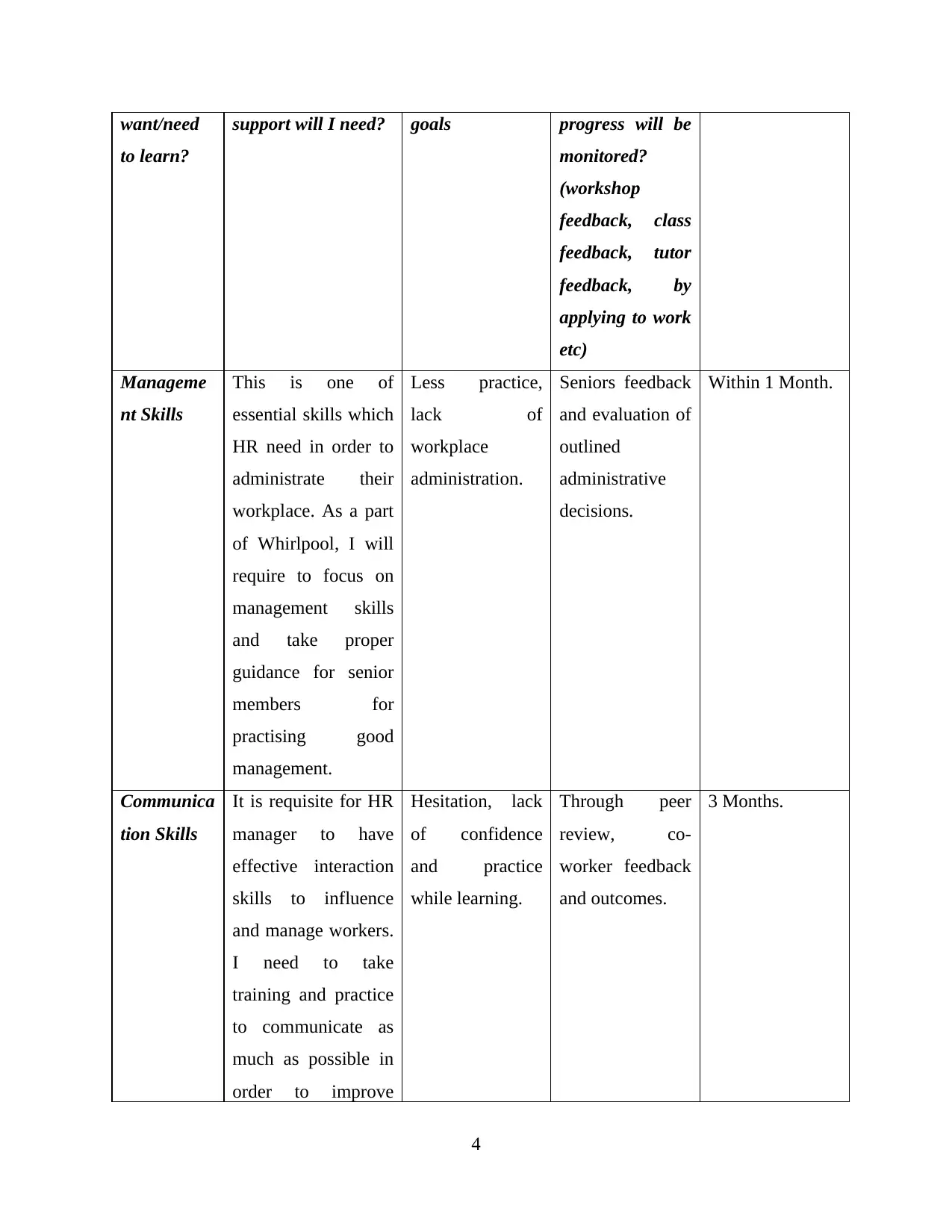
want/need
to learn?
support will I need? goals progress will be
monitored?
(workshop
feedback, class
feedback, tutor
feedback, by
applying to work
etc)
Manageme
nt Skills
This is one of
essential skills which
HR need in order to
administrate their
workplace. As a part
of Whirlpool, I will
require to focus on
management skills
and take proper
guidance for senior
members for
practising good
management.
Less practice,
lack of
workplace
administration.
Seniors feedback
and evaluation of
outlined
administrative
decisions.
Within 1 Month.
Communica
tion Skills
It is requisite for HR
manager to have
effective interaction
skills to influence
and manage workers.
I need to take
training and practice
to communicate as
much as possible in
order to improve
Hesitation, lack
of confidence
and practice
while learning.
Through peer
review, co-
worker feedback
and outcomes.
3 Months.
4
to learn?
support will I need? goals progress will be
monitored?
(workshop
feedback, class
feedback, tutor
feedback, by
applying to work
etc)
Manageme
nt Skills
This is one of
essential skills which
HR need in order to
administrate their
workplace. As a part
of Whirlpool, I will
require to focus on
management skills
and take proper
guidance for senior
members for
practising good
management.
Less practice,
lack of
workplace
administration.
Seniors feedback
and evaluation of
outlined
administrative
decisions.
Within 1 Month.
Communica
tion Skills
It is requisite for HR
manager to have
effective interaction
skills to influence
and manage workers.
I need to take
training and practice
to communicate as
much as possible in
order to improve
Hesitation, lack
of confidence
and practice
while learning.
Through peer
review, co-
worker feedback
and outcomes.
3 Months.
4
⊘ This is a preview!⊘
Do you want full access?
Subscribe today to unlock all pages.

Trusted by 1+ million students worldwide
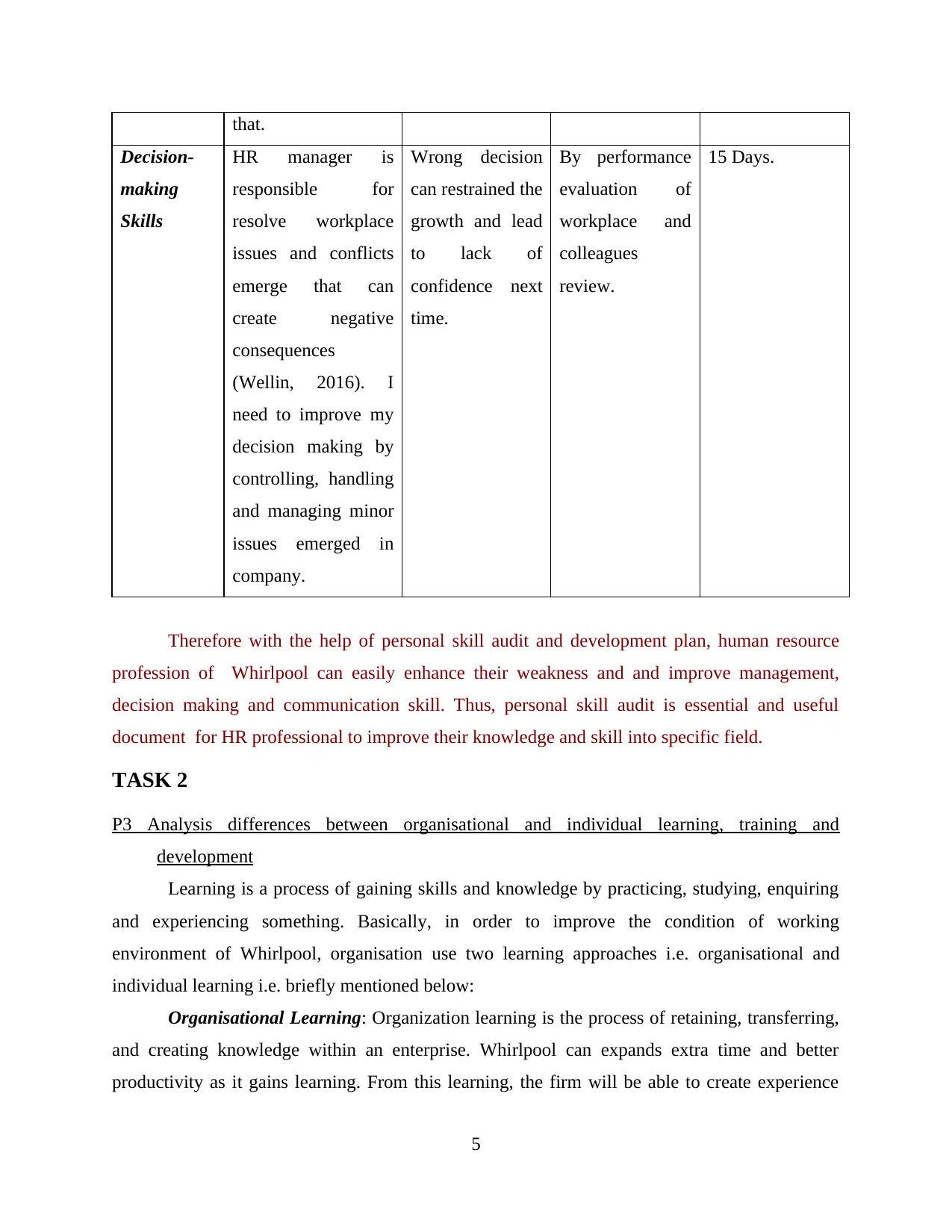
that.
Decision-
making
Skills
HR manager is
responsible for
resolve workplace
issues and conflicts
emerge that can
create negative
consequences
(Wellin, 2016). I
need to improve my
decision making by
controlling, handling
and managing minor
issues emerged in
company.
Wrong decision
can restrained the
growth and lead
to lack of
confidence next
time.
By performance
evaluation of
workplace and
colleagues
review.
15 Days.
Therefore with the help of personal skill audit and development plan, human resource
profession of Whirlpool can easily enhance their weakness and and improve management,
decision making and communication skill. Thus, personal skill audit is essential and useful
document for HR professional to improve their knowledge and skill into specific field.
TASK 2
P3 Analysis differences between organisational and individual learning, training and
development
Learning is a process of gaining skills and knowledge by practicing, studying, enquiring
and experiencing something. Basically, in order to improve the condition of working
environment of Whirlpool, organisation use two learning approaches i.e. organisational and
individual learning i.e. briefly mentioned below:
Organisational Learning: Organization learning is the process of retaining, transferring,
and creating knowledge within an enterprise. Whirlpool can expands extra time and better
productivity as it gains learning. From this learning, the firm will be able to create experience
5
Decision-
making
Skills
HR manager is
responsible for
resolve workplace
issues and conflicts
emerge that can
create negative
consequences
(Wellin, 2016). I
need to improve my
decision making by
controlling, handling
and managing minor
issues emerged in
company.
Wrong decision
can restrained the
growth and lead
to lack of
confidence next
time.
By performance
evaluation of
workplace and
colleagues
review.
15 Days.
Therefore with the help of personal skill audit and development plan, human resource
profession of Whirlpool can easily enhance their weakness and and improve management,
decision making and communication skill. Thus, personal skill audit is essential and useful
document for HR professional to improve their knowledge and skill into specific field.
TASK 2
P3 Analysis differences between organisational and individual learning, training and
development
Learning is a process of gaining skills and knowledge by practicing, studying, enquiring
and experiencing something. Basically, in order to improve the condition of working
environment of Whirlpool, organisation use two learning approaches i.e. organisational and
individual learning i.e. briefly mentioned below:
Organisational Learning: Organization learning is the process of retaining, transferring,
and creating knowledge within an enterprise. Whirlpool can expands extra time and better
productivity as it gains learning. From this learning, the firm will be able to create experience
5
Paraphrase This Document
Need a fresh take? Get an instant paraphrase of this document with our AI Paraphraser
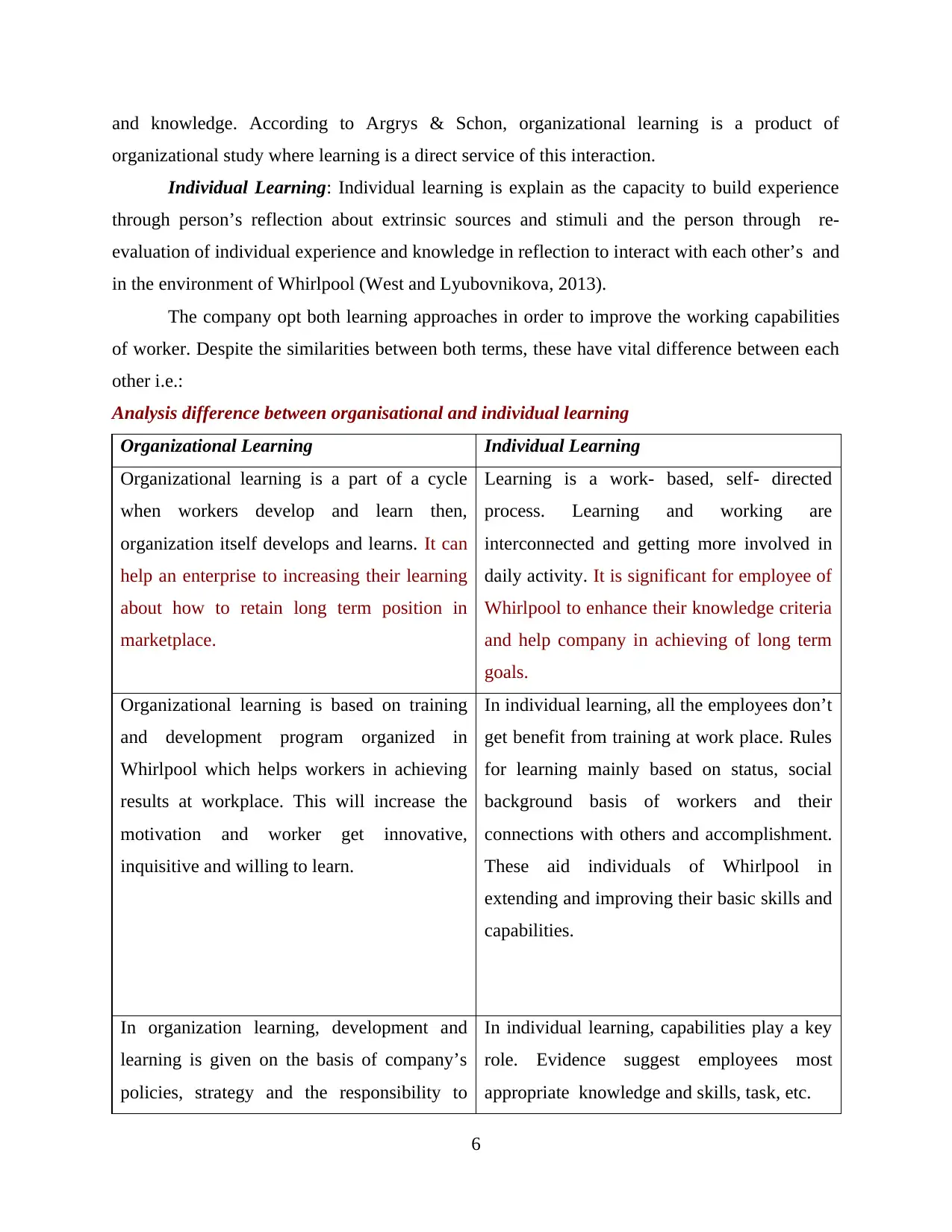
and knowledge. According to Argrys & Schon, organizational learning is a product of
organizational study where learning is a direct service of this interaction.
Individual Learning: Individual learning is explain as the capacity to build experience
through person’s reflection about extrinsic sources and stimuli and the person through re-
evaluation of individual experience and knowledge in reflection to interact with each other’s and
in the environment of Whirlpool (West and Lyubovnikova, 2013).
The company opt both learning approaches in order to improve the working capabilities
of worker. Despite the similarities between both terms, these have vital difference between each
other i.e.:
Analysis difference between organisational and individual learning
Organizational Learning Individual Learning
Organizational learning is a part of a cycle
when workers develop and learn then,
organization itself develops and learns. It can
help an enterprise to increasing their learning
about how to retain long term position in
marketplace.
Learning is a work- based, self- directed
process. Learning and working are
interconnected and getting more involved in
daily activity. It is significant for employee of
Whirlpool to enhance their knowledge criteria
and help company in achieving of long term
goals.
Organizational learning is based on training
and development program organized in
Whirlpool which helps workers in achieving
results at workplace. This will increase the
motivation and worker get innovative,
inquisitive and willing to learn.
In individual learning, all the employees don’t
get benefit from training at work place. Rules
for learning mainly based on status, social
background basis of workers and their
connections with others and accomplishment.
These aid individuals of Whirlpool in
extending and improving their basic skills and
capabilities.
In organization learning, development and
learning is given on the basis of company’s
policies, strategy and the responsibility to
In individual learning, capabilities play a key
role. Evidence suggest employees most
appropriate knowledge and skills, task, etc.
6
organizational study where learning is a direct service of this interaction.
Individual Learning: Individual learning is explain as the capacity to build experience
through person’s reflection about extrinsic sources and stimuli and the person through re-
evaluation of individual experience and knowledge in reflection to interact with each other’s and
in the environment of Whirlpool (West and Lyubovnikova, 2013).
The company opt both learning approaches in order to improve the working capabilities
of worker. Despite the similarities between both terms, these have vital difference between each
other i.e.:
Analysis difference between organisational and individual learning
Organizational Learning Individual Learning
Organizational learning is a part of a cycle
when workers develop and learn then,
organization itself develops and learns. It can
help an enterprise to increasing their learning
about how to retain long term position in
marketplace.
Learning is a work- based, self- directed
process. Learning and working are
interconnected and getting more involved in
daily activity. It is significant for employee of
Whirlpool to enhance their knowledge criteria
and help company in achieving of long term
goals.
Organizational learning is based on training
and development program organized in
Whirlpool which helps workers in achieving
results at workplace. This will increase the
motivation and worker get innovative,
inquisitive and willing to learn.
In individual learning, all the employees don’t
get benefit from training at work place. Rules
for learning mainly based on status, social
background basis of workers and their
connections with others and accomplishment.
These aid individuals of Whirlpool in
extending and improving their basic skills and
capabilities.
In organization learning, development and
learning is given on the basis of company’s
policies, strategy and the responsibility to
In individual learning, capabilities play a key
role. Evidence suggest employees most
appropriate knowledge and skills, task, etc.
6

develop, deliver and plan the strategy.
Therefore organisational and individual learning is important for them to increase their
knowledge and performance. With the help of training and learning, employee of Whirlpool can
easily enhance their knowledge which will also help an organisation to increase their
productivity.
Training: Training is developing or teaching to one and others, any knowledge and skills
i.e. related to the particular essential ability (Sessa and London, 2015). Training in Whirlpool
mainly targets of improving person’s capacity, capability, performance and productivity.
Development: Development can be refer to a procedure that create progress, growth and
positive modification of physical, environmental, economic, demographic and social
components. Development is a process of being developed that can simply define as an
establishing a new stage in any situation emerged in Whirlpool.
Basically, the term is often used together but has vital difference between each other. On
the basis of worker stability and retention, training and development is organized by Whirlpool
to their employee that also aid in delivering high performance working environment. Here are
mentioned some of those benefits:
Analysis difference between training and development
Basis Training Development
Meaning
Training is a process in which
employees get an opportunity to
develop and study knowledge, and
skills as per the job requirement.
Development is a learning process
which is focused on the overall
growth of the staff.
Term Training is a short- process. Development is a long-term process.
Focus Training focus on present knowledge
and skills of an employee.
Development focus on the future
growth of an organization.
Orientation Training is a job- oriented. Developing is a career- oriented.
Motivation In training, the trainer gives motivation
to the trainee so that they can give their
best to the organization.
In development, an employee
motivates oneself to learn more
things.
7
Therefore organisational and individual learning is important for them to increase their
knowledge and performance. With the help of training and learning, employee of Whirlpool can
easily enhance their knowledge which will also help an organisation to increase their
productivity.
Training: Training is developing or teaching to one and others, any knowledge and skills
i.e. related to the particular essential ability (Sessa and London, 2015). Training in Whirlpool
mainly targets of improving person’s capacity, capability, performance and productivity.
Development: Development can be refer to a procedure that create progress, growth and
positive modification of physical, environmental, economic, demographic and social
components. Development is a process of being developed that can simply define as an
establishing a new stage in any situation emerged in Whirlpool.
Basically, the term is often used together but has vital difference between each other. On
the basis of worker stability and retention, training and development is organized by Whirlpool
to their employee that also aid in delivering high performance working environment. Here are
mentioned some of those benefits:
Analysis difference between training and development
Basis Training Development
Meaning
Training is a process in which
employees get an opportunity to
develop and study knowledge, and
skills as per the job requirement.
Development is a learning process
which is focused on the overall
growth of the staff.
Term Training is a short- process. Development is a long-term process.
Focus Training focus on present knowledge
and skills of an employee.
Development focus on the future
growth of an organization.
Orientation Training is a job- oriented. Developing is a career- oriented.
Motivation In training, the trainer gives motivation
to the trainee so that they can give their
best to the organization.
In development, an employee
motivates oneself to learn more
things.
7
⊘ This is a preview!⊘
Do you want full access?
Subscribe today to unlock all pages.

Trusted by 1+ million students worldwide

Objective To improvise the work performance of
a staff.
For preparing workers for future
obstacles.
Number of
individuals
Training is organized for many
workers.
The opportunity of development
gives to only few workers.
Therefore, training and development is important for employees of an organisation by
increasing skills and knowledge about specific area. With the help of training, workers can easily
develop their understanding in regards of business functions and operations. Thus, it will also
helpful for company to gain competitive advantages within given time period.
P4 Need for continuous learning and professional development to drive sustainable business
performance
CPD stands for Continuing Professional Development. It refers to the process of purse
and documenting the experience, skills, and knowledge that one earn both correct and incorrect
as one work, beyond any primary training. This is a narration of what one learns, experience, and
then applies (7 Reasons Why Continuous Learning is Important, 2017). Continuous learning
knowledge is needed to strongly fit to changing life demands and work of Whirlpool. This
learning in the workplace environment involves viewing re-examining assumptions, methods,
practices, values, practices and one’s experience. Whirlpool has planned to carry out some
improvisation within their workplace in order to meet their standard objectives. Hence, in regard
of that, the company has determined to use continuous learning and professional development
approach as this motivate knowledge, skills and experience of a person. Here are briefed some
basic requirements of CPD procedure described below:
Prepare worker for unexpected: This sort of learning will assist employee of Whirlpool
for the unexpected changes incur and can incur (McKenzie, van Winkelen and Grewal, 2011).
Through continuous learning, organization can more easily carry out operations without
remaining in their comfort zone and opt new available opportunities at marketplace.
Enhance the brand reputation: While constant learning, Whirlpool can keep prosper and
develop their operations of organization and begin to meet recommendation accumulated from
market. This enables opportunities to prosper and learn new knowledge and skills accordingly.
Competence direct to confidence: Numerous learning render organizations a better taste
of success which will emphasize their confidence in their own skills and capabilities. Hence,
8
a staff.
For preparing workers for future
obstacles.
Number of
individuals
Training is organized for many
workers.
The opportunity of development
gives to only few workers.
Therefore, training and development is important for employees of an organisation by
increasing skills and knowledge about specific area. With the help of training, workers can easily
develop their understanding in regards of business functions and operations. Thus, it will also
helpful for company to gain competitive advantages within given time period.
P4 Need for continuous learning and professional development to drive sustainable business
performance
CPD stands for Continuing Professional Development. It refers to the process of purse
and documenting the experience, skills, and knowledge that one earn both correct and incorrect
as one work, beyond any primary training. This is a narration of what one learns, experience, and
then applies (7 Reasons Why Continuous Learning is Important, 2017). Continuous learning
knowledge is needed to strongly fit to changing life demands and work of Whirlpool. This
learning in the workplace environment involves viewing re-examining assumptions, methods,
practices, values, practices and one’s experience. Whirlpool has planned to carry out some
improvisation within their workplace in order to meet their standard objectives. Hence, in regard
of that, the company has determined to use continuous learning and professional development
approach as this motivate knowledge, skills and experience of a person. Here are briefed some
basic requirements of CPD procedure described below:
Prepare worker for unexpected: This sort of learning will assist employee of Whirlpool
for the unexpected changes incur and can incur (McKenzie, van Winkelen and Grewal, 2011).
Through continuous learning, organization can more easily carry out operations without
remaining in their comfort zone and opt new available opportunities at marketplace.
Enhance the brand reputation: While constant learning, Whirlpool can keep prosper and
develop their operations of organization and begin to meet recommendation accumulated from
market. This enables opportunities to prosper and learn new knowledge and skills accordingly.
Competence direct to confidence: Numerous learning render organizations a better taste
of success which will emphasize their confidence in their own skills and capabilities. Hence,
8
Paraphrase This Document
Need a fresh take? Get an instant paraphrase of this document with our AI Paraphraser
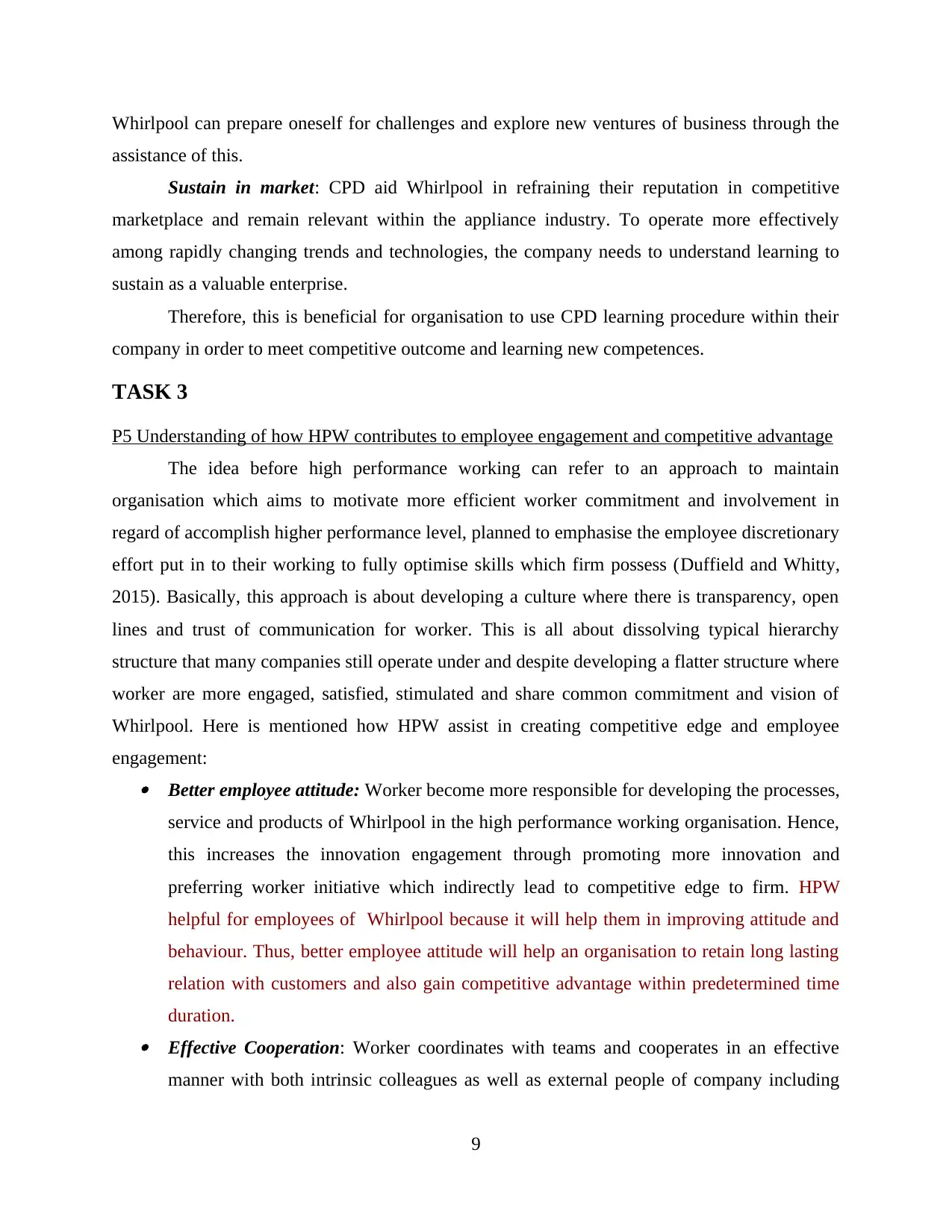
Whirlpool can prepare oneself for challenges and explore new ventures of business through the
assistance of this.
Sustain in market: CPD aid Whirlpool in refraining their reputation in competitive
marketplace and remain relevant within the appliance industry. To operate more effectively
among rapidly changing trends and technologies, the company needs to understand learning to
sustain as a valuable enterprise.
Therefore, this is beneficial for organisation to use CPD learning procedure within their
company in order to meet competitive outcome and learning new competences.
TASK 3
P5 Understanding of how HPW contributes to employee engagement and competitive advantage
The idea before high performance working can refer to an approach to maintain
organisation which aims to motivate more efficient worker commitment and involvement in
regard of accomplish higher performance level, planned to emphasise the employee discretionary
effort put in to their working to fully optimise skills which firm possess (Duffield and Whitty,
2015). Basically, this approach is about developing a culture where there is transparency, open
lines and trust of communication for worker. This is all about dissolving typical hierarchy
structure that many companies still operate under and despite developing a flatter structure where
worker are more engaged, satisfied, stimulated and share common commitment and vision of
Whirlpool. Here is mentioned how HPW assist in creating competitive edge and employee
engagement: Better employee attitude: Worker become more responsible for developing the processes,
service and products of Whirlpool in the high performance working organisation. Hence,
this increases the innovation engagement through promoting more innovation and
preferring worker initiative which indirectly lead to competitive edge to firm. HPW
helpful for employees of Whirlpool because it will help them in improving attitude and
behaviour. Thus, better employee attitude will help an organisation to retain long lasting
relation with customers and also gain competitive advantage within predetermined time
duration. Effective Cooperation: Worker coordinates with teams and cooperates in an effective
manner with both intrinsic colleagues as well as external people of company including
9
assistance of this.
Sustain in market: CPD aid Whirlpool in refraining their reputation in competitive
marketplace and remain relevant within the appliance industry. To operate more effectively
among rapidly changing trends and technologies, the company needs to understand learning to
sustain as a valuable enterprise.
Therefore, this is beneficial for organisation to use CPD learning procedure within their
company in order to meet competitive outcome and learning new competences.
TASK 3
P5 Understanding of how HPW contributes to employee engagement and competitive advantage
The idea before high performance working can refer to an approach to maintain
organisation which aims to motivate more efficient worker commitment and involvement in
regard of accomplish higher performance level, planned to emphasise the employee discretionary
effort put in to their working to fully optimise skills which firm possess (Duffield and Whitty,
2015). Basically, this approach is about developing a culture where there is transparency, open
lines and trust of communication for worker. This is all about dissolving typical hierarchy
structure that many companies still operate under and despite developing a flatter structure where
worker are more engaged, satisfied, stimulated and share common commitment and vision of
Whirlpool. Here is mentioned how HPW assist in creating competitive edge and employee
engagement: Better employee attitude: Worker become more responsible for developing the processes,
service and products of Whirlpool in the high performance working organisation. Hence,
this increases the innovation engagement through promoting more innovation and
preferring worker initiative which indirectly lead to competitive edge to firm. HPW
helpful for employees of Whirlpool because it will help them in improving attitude and
behaviour. Thus, better employee attitude will help an organisation to retain long lasting
relation with customers and also gain competitive advantage within predetermined time
duration. Effective Cooperation: Worker coordinates with teams and cooperates in an effective
manner with both intrinsic colleagues as well as external people of company including
9
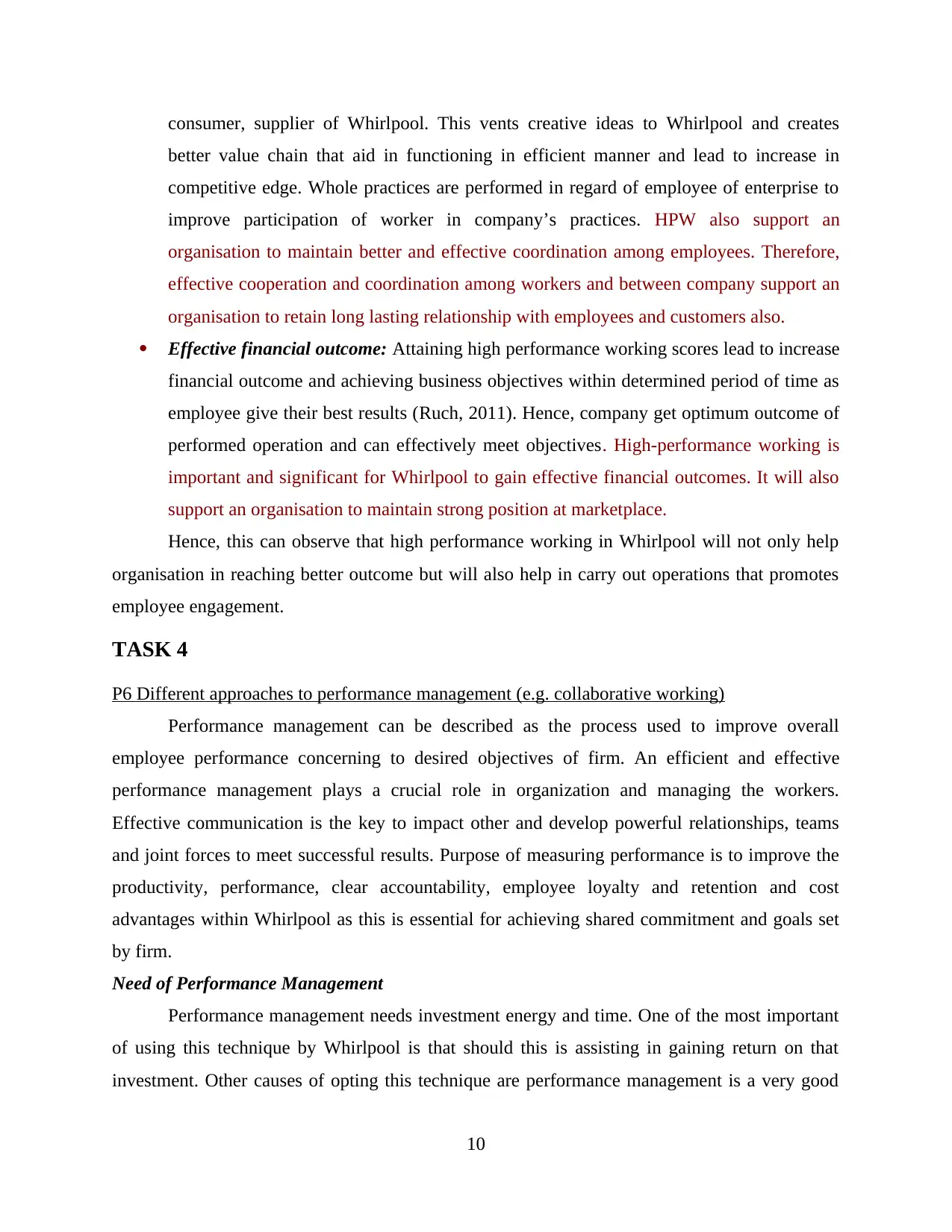
consumer, supplier of Whirlpool. This vents creative ideas to Whirlpool and creates
better value chain that aid in functioning in efficient manner and lead to increase in
competitive edge. Whole practices are performed in regard of employee of enterprise to
improve participation of worker in company’s practices. HPW also support an
organisation to maintain better and effective coordination among employees. Therefore,
effective cooperation and coordination among workers and between company support an
organisation to retain long lasting relationship with employees and customers also.
Effective financial outcome: Attaining high performance working scores lead to increase
financial outcome and achieving business objectives within determined period of time as
employee give their best results (Ruch, 2011). Hence, company get optimum outcome of
performed operation and can effectively meet objectives. High-performance working is
important and significant for Whirlpool to gain effective financial outcomes. It will also
support an organisation to maintain strong position at marketplace.
Hence, this can observe that high performance working in Whirlpool will not only help
organisation in reaching better outcome but will also help in carry out operations that promotes
employee engagement.
TASK 4
P6 Different approaches to performance management (e.g. collaborative working)
Performance management can be described as the process used to improve overall
employee performance concerning to desired objectives of firm. An efficient and effective
performance management plays a crucial role in organization and managing the workers.
Effective communication is the key to impact other and develop powerful relationships, teams
and joint forces to meet successful results. Purpose of measuring performance is to improve the
productivity, performance, clear accountability, employee loyalty and retention and cost
advantages within Whirlpool as this is essential for achieving shared commitment and goals set
by firm.
Need of Performance Management
Performance management needs investment energy and time. One of the most important
of using this technique by Whirlpool is that should this is assisting in gaining return on that
investment. Other causes of opting this technique are performance management is a very good
10
better value chain that aid in functioning in efficient manner and lead to increase in
competitive edge. Whole practices are performed in regard of employee of enterprise to
improve participation of worker in company’s practices. HPW also support an
organisation to maintain better and effective coordination among employees. Therefore,
effective cooperation and coordination among workers and between company support an
organisation to retain long lasting relationship with employees and customers also.
Effective financial outcome: Attaining high performance working scores lead to increase
financial outcome and achieving business objectives within determined period of time as
employee give their best results (Ruch, 2011). Hence, company get optimum outcome of
performed operation and can effectively meet objectives. High-performance working is
important and significant for Whirlpool to gain effective financial outcomes. It will also
support an organisation to maintain strong position at marketplace.
Hence, this can observe that high performance working in Whirlpool will not only help
organisation in reaching better outcome but will also help in carry out operations that promotes
employee engagement.
TASK 4
P6 Different approaches to performance management (e.g. collaborative working)
Performance management can be described as the process used to improve overall
employee performance concerning to desired objectives of firm. An efficient and effective
performance management plays a crucial role in organization and managing the workers.
Effective communication is the key to impact other and develop powerful relationships, teams
and joint forces to meet successful results. Purpose of measuring performance is to improve the
productivity, performance, clear accountability, employee loyalty and retention and cost
advantages within Whirlpool as this is essential for achieving shared commitment and goals set
by firm.
Need of Performance Management
Performance management needs investment energy and time. One of the most important
of using this technique by Whirlpool is that should this is assisting in gaining return on that
investment. Other causes of opting this technique are performance management is a very good
10
⊘ This is a preview!⊘
Do you want full access?
Subscribe today to unlock all pages.

Trusted by 1+ million students worldwide
1 out of 15
Related Documents
Your All-in-One AI-Powered Toolkit for Academic Success.
+13062052269
info@desklib.com
Available 24*7 on WhatsApp / Email
![[object Object]](/_next/static/media/star-bottom.7253800d.svg)
Unlock your academic potential
Copyright © 2020–2025 A2Z Services. All Rights Reserved. Developed and managed by ZUCOL.





